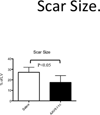AAV9.I-1c delivered via direct coronary infusion in a porcine model of heart failure improves contractility and mitigates adverse remodeling
- PMID: 23271792
- PMCID: PMC3605211
- DOI: 10.1161/CIRCHEARTFAILURE.112.971325
AAV9.I-1c delivered via direct coronary infusion in a porcine model of heart failure improves contractility and mitigates adverse remodeling
Abstract
Background: Heart failure is characterized by impaired function and disturbed Ca2+ homeostasis. Transgenic increases in inhibitor-1 activity have been shown to improve Ca2 cycling and preserve cardiac performance in the failing heart. The aim of this study was to evaluate the effect of activating the inhibitor (I-1c) of protein phosphatase 1 (I-1) through gene transfer on cardiac function in a porcine model of heart failure induced by myocardial infarction.
Methods and results: Myocardial infarction was created by a percutaneous, permanent left anterior descending artery occlusion in Yorkshire Landrace swine (n=16). One month after myocardial infarction, pigs underwent intracoronary delivery of either recombinant adeno-associated virus type 9 carrying I-1c (n=8) or saline (n=6) as control. One month after myocardial infarction was created, animals exhibited severe heart failure demonstrated by decreased ejection fraction (46.4±7.0% versus sham 69.7±8.5%) and impaired (dP/dt)max and (dP/dt)min. Intracoronary injection of AAV9.I-1c prevented further deterioration of cardiac function and led to a decrease in scar size.
Conclusions: In this preclinical model of heart failure, overexpression of I-1c by intracoronary in vivo gene transfer preserved cardiac function and reduced the scar size.
Figures







Similar articles
-
AAV-9 mediated phosphatase-1 inhibitor-1 overexpression improves cardiac contractility in unchallenged mice but is deleterious in pressure-overload.Gene Ther. 2018 Jan;25(1):13-19. doi: 10.1038/gt.2017.97. Epub 2018 Jan 19. Gene Ther. 2018. PMID: 29350681
-
Cardiac I-1c overexpression with reengineered AAV improves cardiac function in swine ischemic heart failure.Mol Ther. 2014 Dec;22(12):2038-2045. doi: 10.1038/mt.2014.127. Epub 2014 Jul 15. Mol Ther. 2014. PMID: 25023328 Free PMC article.
-
Cardiac AAV9-S100A1 gene therapy rescues post-ischemic heart failure in a preclinical large animal model.Sci Transl Med. 2011 Jul 20;3(92):92ra64. doi: 10.1126/scitranslmed.3002097. Sci Transl Med. 2011. PMID: 21775667 Free PMC article.
-
Progress in gene therapy for heart failure.J Cardiovasc Pharmacol. 2014 Feb;63(2):95-106. doi: 10.1097/FJC.0b013e3182a2e8b8. J Cardiovasc Pharmacol. 2014. PMID: 23921315 Review.
-
Heart failure after myocardial infarction: clinical implications and treatment.Clin Cardiol. 2011 Jul;34(7):410-4. doi: 10.1002/clc.20922. Epub 2011 Jun 17. Clin Cardiol. 2011. PMID: 21688276 Free PMC article. Review.
Cited by
-
Nanomedicine for Gene Delivery for the Treatment of Cardiovascular Diseases.Curr Gene Ther. 2019;19(1):20-30. doi: 10.2174/1566523218666181003125308. Curr Gene Ther. 2019. PMID: 30280665 Free PMC article. Review.
-
AAV-9 mediated phosphatase-1 inhibitor-1 overexpression improves cardiac contractility in unchallenged mice but is deleterious in pressure-overload.Gene Ther. 2018 Jan;25(1):13-19. doi: 10.1038/gt.2017.97. Epub 2018 Jan 19. Gene Ther. 2018. PMID: 29350681
-
Cell therapy for cardiac repair--lessons from clinical trials.Nat Rev Cardiol. 2014 Apr;11(4):232-46. doi: 10.1038/nrcardio.2014.9. Epub 2014 Mar 4. Nat Rev Cardiol. 2014. PMID: 24594893 Review.
-
Phospholamban interactome in cardiac contractility and survival: A new vision of an old friend.J Mol Cell Cardiol. 2014 Dec;77:160-7. doi: 10.1016/j.yjmcc.2014.10.005. Epub 2014 Oct 18. J Mol Cell Cardiol. 2014. PMID: 25451386 Free PMC article. Review.
-
Cardiac gene therapy with adeno-associated virus-based vectors.Curr Opin Cardiol. 2017 May;32(3):275-282. doi: 10.1097/HCO.0000000000000386. Curr Opin Cardiol. 2017. PMID: 28169951 Free PMC article.
References
-
- Hasenfuss G, Pieske B. Calcium cycling in congestive heart failure. J Mol Cell Cardiol. 2002;34:951–969. - PubMed
-
- Hasenfuss G, Reinecke H, Studer R, Pieske B, Meyer M, Drexler H, Just H. Calcium cycling proteins and force-frequency relationship in heart failure. Basic Res Cardiol. 1996;91 Suppl 2:17–22. - PubMed
-
- Gwathmey JK, Copelas L, MacKinnon R, Schoen FJ, Feldman MD, Grossman W, Morgan JP. Abnormal intracellular calcium handling in myocardium from patients with end-stage heart failure. Circ Res. 1987;61:70–76. - PubMed
-
- Gwathmey JK, Hajjar RJ. Intracellular calcium related to force development in twitch contraction of mammalian myocardium. Cell Calcium. 1990;11:531–538. - PubMed
Publication types
MeSH terms
Substances
Grants and funding
- P50 HL112324/HL/NHLBI NIH HHS/United States
- K01 HL103176/HL/NHLBI NIH HHS/United States
- R01 HL026057/HL/NHLBI NIH HHS/United States
- P20HL100396/HL/NHLBI NIH HHS/United States
- R01 HL080498/HL/NHLBI NIH HHS/United States
- HL64018/HL/NHLBI NIH HHS/United States
- HL080498/HL/NHLBI NIH HHS/United States
- P20 HL100396/HL/NHLBI NIH HHS/United States
- HL083156/HL/NHLBI NIH HHS/United States
- R01 HL083156/HL/NHLBI NIH HHS/United States
- R01 HL064018/HL/NHLBI NIH HHS/United States
- R01 HL093183/HL/NHLBI NIH HHS/United States
- R01 HL071763/HL/NHLBI NIH HHS/United States
- HL088434/HL/NHLBI NIH HHS/United States
- HL26057/HL/NHLBI NIH HHS/United States
- R37 HL026057/HL/NHLBI NIH HHS/United States
- R01 HL088434/HL/NHLBI NIH HHS/United States
- HL071763/HL/NHLBI NIH HHS/United States
LinkOut - more resources
Full Text Sources
Other Literature Sources
Medical
Miscellaneous

